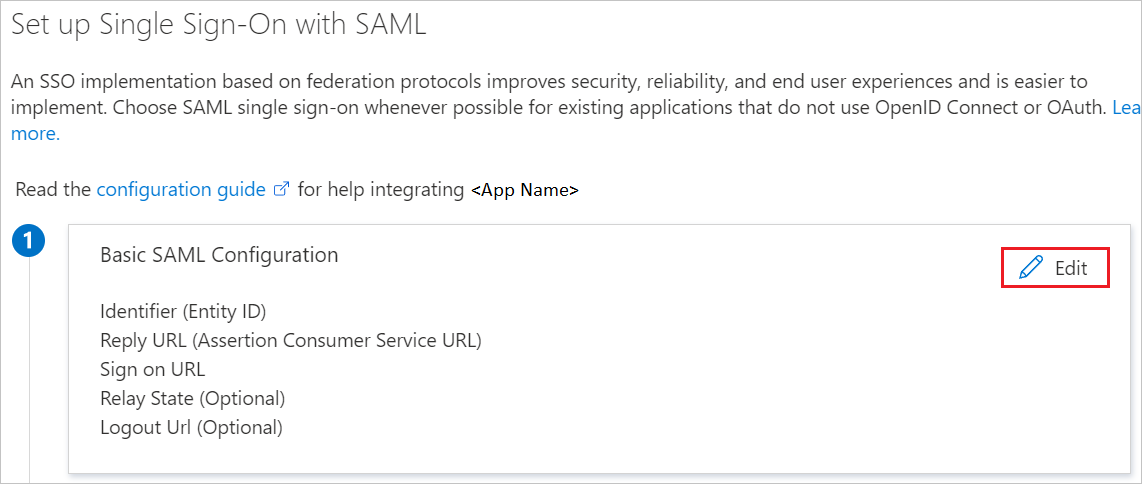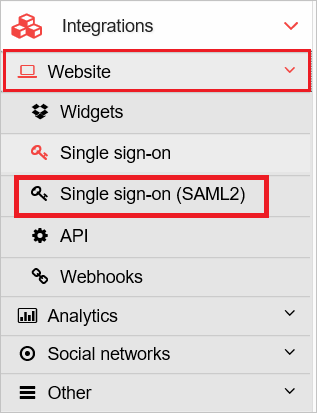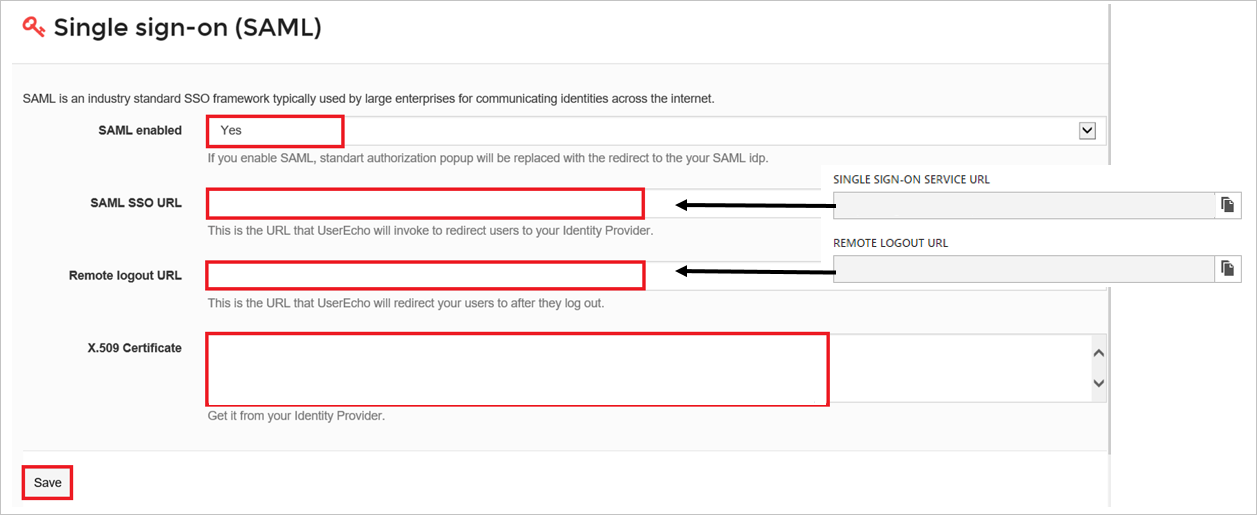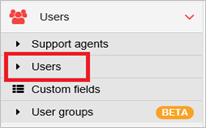Tutorial: Microsoft Entra SSO integration with UserEcho
In this tutorial, you'll learn how to integrate UserEcho with Microsoft Entra ID. When you integrate UserEcho with Microsoft Entra ID, you can:
- Control in Microsoft Entra ID who has access to UserEcho.
- Enable your users to be automatically signed-in to UserEcho with their Microsoft Entra accounts.
- Manage your accounts in one central location.
Prerequisites
To configure Microsoft Entra integration with UserEcho, you need the following items:
- A Microsoft Entra subscription. If you don't have a Microsoft Entra environment, you can get a free account.
- UserEcho single sign-on enabled subscription.
- Along with Cloud Application Administrator, Application Administrator can also add or manage applications in Microsoft Entra ID. For more information, see Azure built-in roles.
Scenario description
In this tutorial, you configure and test Microsoft Entra single sign-on in a test environment.
- UserEcho supports SP initiated SSO.
Add UserEcho from the gallery
To configure the integration of UserEcho into Microsoft Entra ID, you need to add UserEcho from the gallery to your list of managed SaaS apps.
- Sign in to the Microsoft Entra admin center as at least a Cloud Application Administrator.
- Browse to Identity > Applications > Enterprise applications > New application.
- In the Add from the gallery section, type UserEcho in the search box.
- Select UserEcho from results panel and then add the app. Wait a few seconds while the app is added to your tenant.
Alternatively, you can also use the Enterprise App Configuration Wizard. In this wizard, you can add an application to your tenant, add users/groups to the app, assign roles, as well as walk through the SSO configuration as well. Learn more about Microsoft 365 wizards.
Configure and test Microsoft Entra SSO for UserEcho
Configure and test Microsoft Entra SSO with UserEcho using a test user called B.Simon. For SSO to work, you need to establish a link relationship between a Microsoft Entra user and the related user in UserEcho.
To configure and test Microsoft Entra SSO with UserEcho, perform the following steps:
- Configure Microsoft Entra SSO - to enable your users to use this feature.
- Create a Microsoft Entra test user - to test Microsoft Entra single sign-on with B.Simon.
- Assign the Microsoft Entra test user - to enable B.Simon to use Microsoft Entra single sign-on.
- Configure UserEcho SSO - to configure the single sign-on settings on application side.
- Create UserEcho test user - to have a counterpart of B.Simon in UserEcho that is linked to the Microsoft Entra representation of user.
- Test SSO - to verify whether the configuration works.
Configure Microsoft Entra SSO
Follow these steps to enable Microsoft Entra SSO.
Sign in to the Microsoft Entra admin center as at least a Cloud Application Administrator.
Browse to Identity > Applications > Enterprise applications > UserEcho > Single sign-on.
On the Select a single sign-on method page, select SAML.
On the Set up single sign-on with SAML page, click the pencil icon for Basic SAML Configuration to edit the settings.

On the Basic SAML Configuration section, perform the following steps:
a. In the Identifier (Entity ID) text box, type a URL using the following pattern:
https://<companyname>.userecho.com/saml/metadata/b. In the Sign on URL text box, type a URL using the following pattern:
https://<companyname>.userecho.com/Note
These values are not real. Update these values with the actual Identifier and Sign on URL. Contact UserEcho Client support team to get these values. You can also refer to the patterns shown in the Basic SAML Configuration section.
On the Set up Single Sign-On with SAML page, in the SAML Signing Certificate section, click Download to download the Certificate (Base64) from the given options as per your requirement and save it on your computer.

On the Set up UserEcho section, copy the appropriate URL(s) as per your requirement.

Create a Microsoft Entra test user
In this section, you'll create a test user called B.Simon.
- Sign in to the Microsoft Entra admin center as at least a User Administrator.
- Browse to Identity > Users > All users.
- Select New user > Create new user, at the top of the screen.
- In the User properties, follow these steps:
- In the Display name field, enter
B.Simon. - In the User principal name field, enter the username@companydomain.extension. For example,
B.Simon@contoso.com. - Select the Show password check box, and then write down the value that's displayed in the Password box.
- Select Review + create.
- In the Display name field, enter
- Select Create.
Assign the Microsoft Entra test user
In this section, you'll enable B.Simon to use single sign-on by granting access to UserEcho.
- Sign in to the Microsoft Entra admin center as at least a Cloud Application Administrator.
- Browse to Identity > Applications > Enterprise applications > UserEcho.
- In the app's overview page, find the Manage section and select Users and groups.
- Select Add user, then select Users and groups in the Add Assignment dialog.
- In the Users and groups dialog, select B.Simon from the Users list, then click the Select button at the bottom of the screen.
- If you're expecting any role value in the SAML assertion, in the Select Role dialog, select the appropriate role for the user from the list and then click the Select button at the bottom of the screen.
- In the Add Assignment dialog, click the Assign button.
Configure UserEcho SSO
In another browser window, sign on to your UserEcho company site as an administrator.
In the toolbar on the top, click your user name to expand the menu, and then click Setup.

Click Integrations.

Click Website, and then click Single sign-on (SAML2).

On the Single sign-on (SAML) page, perform the following steps:

a. As SAML-enabled, select Yes.
b. Paste Login URL into the SAML SSO URL textbox.
c. Paste Logout URL into the Remote Logout URL textbox.
d. Open your downloaded certificate in Notepad, copy the content, and then paste it into the X.509 Certificate textbox.
e. Click Save.
Create UserEcho test user
The objective of this section is to create a user called Britta Simon in UserEcho.
To create a user called Britta Simon in UserEcho, perform the following steps:
Sign-on to your UserEcho company site as an administrator.
In the toolbar on the top, click your user name to expand the menu, and then click Setup.

Click Users, to expand the Users section.

Click Users.

Click Invite a new user.

On the Invite a new user dialog, perform the following steps:

a. In the Name textbox, type name of the user like Britta Simon.
b. In the Email textbox, type the email address of user like Brittasimon@contoso.com.
c. Click Invite.
Test SSO
In this section, you test your Microsoft Entra single sign-on configuration with following options.
Click on Test this application, this will redirect to UserEcho Sign-on URL where you can initiate the login flow.
Go to UserEcho Sign-on URL directly and initiate the login flow from there.
You can use Microsoft My Apps. When you click the UserEcho tile in the My Apps, this will redirect to UserEcho Sign-on URL. For more information, see Microsoft Entra My Apps.
Next steps
Once you configure UserEcho you can enforce session control, which protects exfiltration and infiltration of your organization’s sensitive data in real time. Session control extends from Conditional Access. Learn how to enforce session control with Microsoft Cloud App Security.